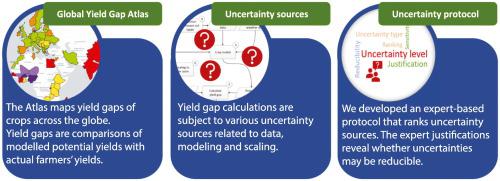Agricultural Systems ( IF 6.6 ) Pub Date : 2021-11-11 , DOI: 10.1016/j.agsy.2021.103311 René L.M. Schils 1, 2 , George A.K. van Voorn 3 , Patricio Grassini 4 , Martin K. van Ittersum 1

|
CONTEXT
Yield gap analysis plays an important role in determining potential food availability. The Global Yield Gap Atlas maps yield gaps of crops from point to regional scale across the globe. The calculated yield gaps are based on comparisons between modelled potential yields with actual farmers' yields derived from statistical sources. The calculations are subject to uncertainty due to various sources, including measurement errors, modelling limitations, and scaling issues.
OBJECTIVES
An important goal of the Atlas is to convey an uncertainty evaluation of the yield gap analysis. The aim of this paper is to provide a practical methodology that can make the assessment of the uncertainty by experts explicit and accessible for users of the Atlas.
METHODS
We developed an uncertainty protocol and guidelines listing several sources of uncertainty to be considered by country agronomists who were involved in the calculation of the yield gaps. These experts are asked to score the level of uncertainty of each source, as well as the relative impact of each source. Both scores are combined into uncertainty scores for each source. Aggregated uncertainty scores for yield gaps, potential and actual yields are mapped as colours in the Atlas to indicate ranking. Moreover, experts are encouraged to provide a justification for their scores, which are also made available to users of the Atlas.
RESULTS AND CONCLUSIONS
The uncertainty protocol was applied to 189 country-crop combinations by fourteen experts. They ranked lack of data for model calibration, model sensitivity to specific conditions, weather data, and the data quality on cropping system as the most important uncertainty sources for potential yields. The quality of yield data was ranked as the highest source of uncertainty for actual yields. The justifications provided by experts suggest which uncertainty sources may be reducible with relatively little effort, while other uncertainty sources may be more difficult or impractical to address.
SIGNIFICANCE
The decision making on options to improve food production is better informed when uncertainties are accounted for. The proposed uncertainty protocol allows users to distinguish between different sources of uncertainty as well as their level and relative effect on the end result. The ranking of uncertainty sources suggests a prioritization of future effort to reduce the uncertainty around yield gaps. The justifications given by the experts can provide suggestions for options to reduce uncertainty.
中文翻译:

不确定性不仅仅是数字或颜色:让专家参与产量差距的不确定性评估
语境
产量差距分析在确定潜在粮食供应方面发挥着重要作用。全球产量差距地图集绘制了全球从点到区域尺度的作物产量差距。计算出的产量差距是基于模拟潜在产量与从统计来源得出的实际农民产量之间的比较。由于各种来源,包括测量误差、建模限制和缩放问题,计算受到不确定性的影响。
目标
Atlas 的一个重要目标是传达对产量差距分析的不确定性评估。本文的目的是提供一种实用的方法,可以使专家对不确定性的评估变得清晰,并且可供 Atlas 用户使用。
方法
我们制定了一个不确定性协议和指南,列出了参与计算产量差距的国家农艺师要考虑的几种不确定性来源。这些专家被要求对每个来源的不确定性水平以及每个来源的相对影响进行评分。两个分数都被组合成每个来源的不确定性分数。产量差距、潜在和实际产量的汇总不确定性分数在地图集中映射为颜色以指示排名。此外,鼓励专家为他们的分数提供理由,这些分数也提供给 Atlas 的用户。
结果和结论
14 位专家将不确定性协议应用于 189 种乡村作物组合。他们将模型校准数据的缺乏、模型对特定条件的敏感性、天气数据和种植系统的数据质量列为潜在产量的最重要的不确定性来源。产量数据的质量被列为实际产量的最高不确定性来源。专家提供的理由表明,哪些不确定性来源可以通过相对较少的努力减少,而其他不确定性来源可能更难以解决或不切实际。
意义
当考虑到不确定性时,可以更好地了解关于改善粮食生产的选择的决策。提议的不确定性协议允许用户区分不同的不确定性来源以及它们对最终结果的水平和相对影响。不确定性来源的排名表明,优先考虑未来努力减少围绕产量差距的不确定性。专家给出的理由可以为减少不确定性的选项提供建议。


























 京公网安备 11010802027423号
京公网安备 11010802027423号